|
|
|
|
GammaTech Durabook S15H
Affordable, well-made, Intel Haswell-powered, magnesium alloy-bodied semi-rugged notebook with large wide-format 15.6-inch display — a wolf in sheep's clothing
(by Conrad H. Blickenstorfer; photography by Carol Cotton; see summary review here)
When your business is reviewing rugged mobile computing products, you're often asked what is best, which particular model to buy, or what's the optimal solution for this or that deployment. The answer is always the same—"It depends." That's especially true for notebooks. Unlike consumer notebooks live pampered lives on desks, laps and perhaps a field office or class room, rugged computers will experience a wide variety of conditions, and not all of them pleasant. Adverse conditions range from mild — like use in a field office — to specific — like use in a vehicle — to truly extreme. Truly extreme costs more and it also means compromise. The folks at GammaTech USA know that and offer a range of durable and semi-rugged systems that do the job without breaking the bank. The Durabook S15H, introduced in February of 2014, is prime example.
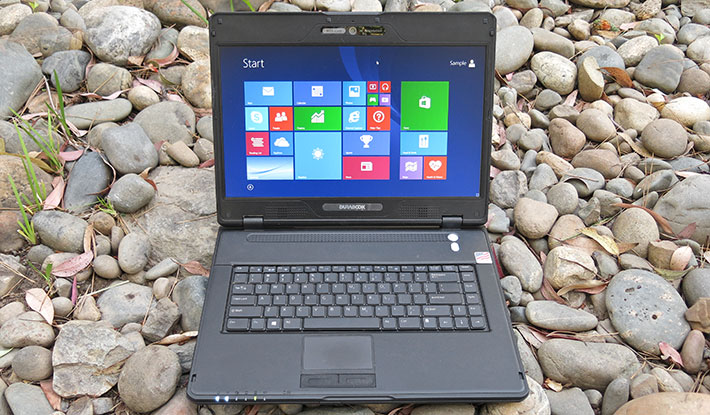
The Durabook S15H
The GammaTech Durabook S15H is a contemporary laptop solution for customers who seek more durability and ruggedness than consumer notebooks generally provide, but still at an affordable price. GammaTech also sought to make available a product that could easily easily be adapted to any application or environment. Right upfront: the starting MSRP of the DURABOOK S15H is US$1,399. That's about twice as much as a decent consumer notebook, but only about half as much as a dedicated vertical market rugged notebook. What will customers get?
That would be a substantial notebook computer designed to be considerably tougher and more durable than standard consumer notebooks, but without the extra size, weight and cost of a fully rugged design. We're talking spill-proof rather than fully water-proof, and tough enough rather than all-out rugged. It's a solid, trust-inspiring machine with a magnesium-alloy case, a large 15.6-inch wide-format display, good connectivity, and good day-to-day functionality. The primary attraction, however, is the switch to "Haswell," Intel's 4th generation of Core processors that provide extra speed, improved graphics, and significantly improved economy via new power conservation modes.
In an era of super-slender tablets and ever-thinner Ultrabooks, the Durabook S15H remains a full-size notebook with a big screen. It measures 14.6 x 10.9 x 1.5 inches and weighs 6.6 pounds, making it a bit thicker and heavier than a standard consumer notebook in this class, but not by much. It is rather elegant with a semi-matte dark gray body and a large matte-silver insert on top. The look nicely captures this Durabook's purpose of being about halfway between a standard consumer notebook and a fully rugged one.
All the conveniences and features of a consumer notebook are there: a very legible full-size keyboard, a suitably large and quick hard disk (ours had a 500GB), a DVD multi drive, a wealth of card readers (ExpressCard, Smart Card, 4-in-1 multi-card, SIM), enough memory (we had 16GB of speedy DDR3), and plenty of onboard connectivity both wired and wireless. GammaTech always offers your choice of Intel's latest processors, and so customers have their choice of Core i3, i5, and i7 chips. Our tester came with a 2.53GHz Core i5-460M dual-core processor that represents a mid-range configuration for the S15C.
The Durabook S15C has a magnesium alloy case, very solid display hinges, rubberized overmolding around the bottom edges and corners, and it generally feels very solid. Note, though, that ports and card slots are open and do not have sealing or protective doors. This is not a sealed machine. Instead, GammaTech designed it to be "spill-resistant," i.e. it can handle the typical coffee and soda spills and perhaps a bit of rain, but not more than that.
Design, look, and feel
Below you can see the GammaTech Durabook S15H from the top and all four sides. The magnesium alloy case is light, yet, GammaTech points out, many times stronger than ABS plastic. The computer doesn't flex and twist like most plastic consumer laptops. The top of the LCD case is matte silver with black plastic top and badge holder. The top could perhaps be a bit more contoured so as to add extra stiffness and better project the tough tool-for-the-job look common in most semi- and fully rugged notebooks. The LCD hinges offer just the right degree of resistance when opening and closing the computer. When you close the lid, two small latches snap into place, securing the LCD case in place when in closed position. To open the notebook again, you simply pull.
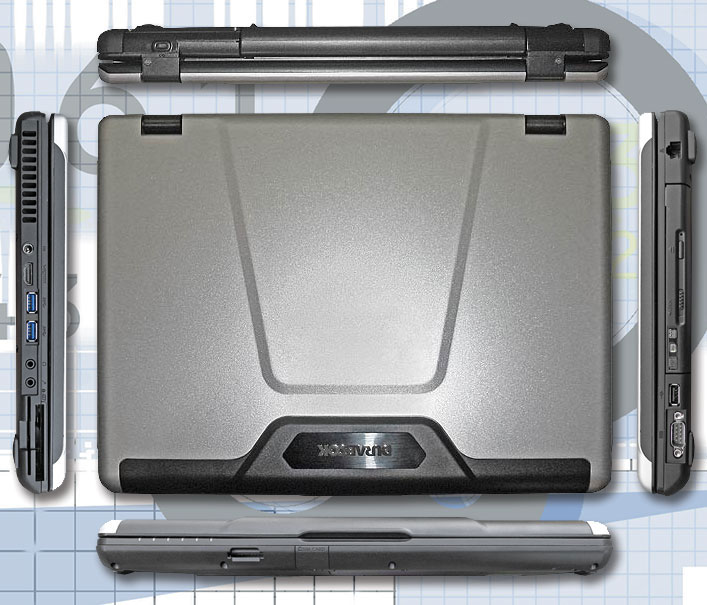
Ports and connectivity are located on the left and right side and the front of the computer. All ports are exposed, except for the LAN and modem port on the right that has a detachable protective rubber plug.
The two pictures below show a more detailed view of the left and right side of the Durabook.

On the left side (above), from left to right, are vents for the unit's heat exchanger fan, the power jack, an HDMI port, two full-size USB 3.0 ports, separate headphone and microphone jacks, an ExpressCard 34/54 slot, and a Smart Card socket.

On the right side, from left to right, is a standard VGA port, a DB9 RS232 serial port, the unit's optical drive (a DVD Super Multi writer in our evaluation machine), and next to that an RJ45 gigabit LAN jack.
On the front of the machine you find a card reader that supports SD, SDXC (which has a theoretical limit of 2TB!), as well as Mini-SD and Micro-SD cards via adapters. The predecessor S15C's reader also read Sony Memory Stick and Memory Stick Pro, but those have become largely irrelevant. There are also six indicator lights (power status, WiFi, rotating media operation, num-lock, caps lock, and battery status (green to orange to red)).
Below you can see the bottom of the Durabook S15H with its access covers removed.
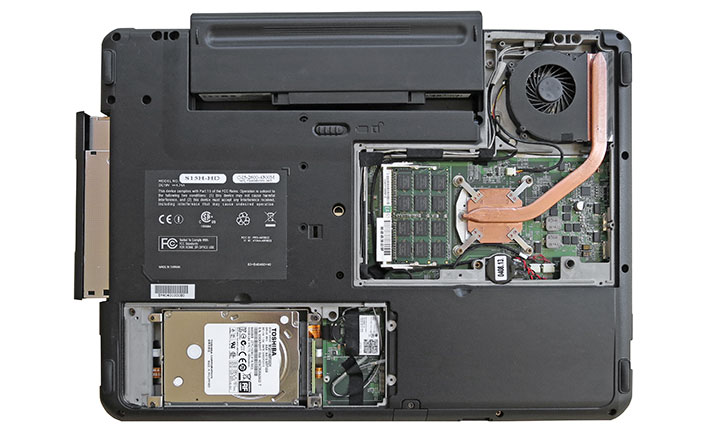
On top you can see the 11.1 Volt/ 7,800mAH battery that slides into the back of the system netbook-style. Its 86.6 watt-hour capacity dwarves the barely adequate 48 watt-hour battery the predecessor S15C had when it came to our lab three years ago. also provides no more than netbook style capacity. It secures into place with a spring-loaded lever, but the fit could be better. This high capacity 9-cell battery appears to be standard now (originally it was listed as an option to a smaller 6-cell 5,200mAh battery). We definitely applaud the switch to a more powerful battery.
On the bottom left is the storage compartment that houses the hard disk. The disk sits in a separate shock-mounted caddy. Our tester came with a 500GB Toshiba MQ01ABF050H spinning at 5,400 rpm and using a 3Gb/s SATA interface. GammaTech offers hard disks up to 750GB, and also solid state disks of various capacities. If additional ruggedness and performance are an issue, SSDs bring substantial benefits.
Next to the data storage compartment is a wireless communications area with two mini PCIe slots. In our unit, one was taken by an Intel Wireless-N 7260 single band 802.11b/g/n "half card" module (see Intel Wireless-N 7260 here). The little module supports some Intel-only features, such as Intel Wireless Display that allows wireless sharing of video, pics or internet on wireless-enabled HDTVs. There's also Intel Smart Connect Technology (auto email and social media updates)and Intel WiFi Hotspot Assistant (auto-roaming). Both the main and the auxiliary antenna were connected. The second mini PCIe slot sat empty, dual antennas ready for connection to a WWAN radio module or similar.
Underneath the larger of the two covers are the Durabook's two DDR3 SODIMM memory slots and the thermal hardware that keeps the machine cool even with its rather powerful processor. It consist of a metal heat spreader plate conducting heat away from the Intel Core processor and accompanying chipset. A copper heat pipe then transfers the heat to the system's fan.
Note that these covers are not meant to seal the unit. They do not have rubber seals or gaskets, and some have air vents.
We didn't disassemble the Durabook further, but even a brief look inside the two service compartment reveals the high degree of quality and design/manufacturing expertise that went into the magnesium-alloy chassis and case of this laptop. You could probably argue that its internal strength and sophistication isn't really reflected in the rather bland and featureless exterior. This machine deserves a more aggressive and contoured exterior and cover!
Keyboard and touch pad
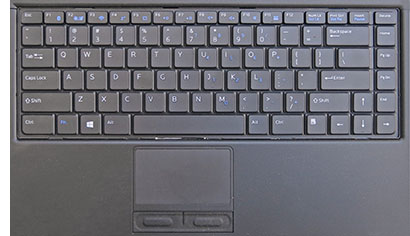 The Durabook S15H's keyboard is full-scale and has 88 keys. The key design is standard notebook (as opposed to the "chiclet" style keys often found in rugged machines) and the keys are black with white letters, numbers and symbols. Functions are indicated in blue. Fonts, font weight and overall design are subdued and elegant, and look great. The keyboard doesn't have a backlight. The Durabook S15H's keyboard is full-scale and has 88 keys. The key design is standard notebook (as opposed to the "chiclet" style keys often found in rugged machines) and the keys are black with white letters, numbers and symbols. Functions are indicated in blue. Fonts, font weight and overall design are subdued and elegant, and look great. The keyboard doesn't have a backlight.
Below the keyboard is the unit's touch pad. It is a properly sized and flush-mounted affair with two large and very responsive mouse buttons in front of it. The touch pad is a pleasure to use, but it can't be operated with gloves on (though it does pick up through some materials, like suede).
The lower left corner of the picture you can see six notification lights. Above the keyboard on the right are the power button and the wireless on/off button. Both have a strong blue backlight and they are clearly marked (in addition to the power button being round and the WiFi button oval).
Performance
Everyone wants a fast computer, but also one that doesn't quickly drain the battery. This used to be nearly impossible. You either got one or the other, but not both. And compromises generally didn't please anyone. That has changed thanks to the tremendous advances in processor technology over the past few years. Intel's latest processor generations provide superior performance while, at the same time, also conserving power far better than ever before. That's especially amazing since the last few generations of Intel processors also include integrated graphics that are now good enough to eliminate the need for discrete graphics sub-systems in most applications.
If there's a flip side to all those wonderful advances in micro processors, it's that there's also been a tremendous increase in the number of processors that often differ in only the minutest way. At this point, Intel offers over one thousand different processors, ranging from low-end Atom chips for targeted applications all the way up to ultra-powerful multi-core processors for high-end near-supercomputing. And not only do these processors offer widely different performance levels, but they also may or may not include large number of Intel technologies and features that may or may not be important to a particular customer. So what processor did GammaTech for the S15H, and why?
They decided to give users several choices. From what we can tell, as of this writing (mid-June 2014), GammaTech offers the following Intel processor options:
|
DURABOOK S15H: Intel processor options
|
|
PROCESSOR COMPARISON
|
Core i7
|
Core i5
|
Pentium
|
|
Model
|
4600M
|
4300M
|
3550M
|
|
Cores/Threads
|
2/4
|
2/4
|
2/2
|
|
Base Clock Speed
|
2.90 GHz
|
2.60 GHz
|
2.30 GHz
|
|
Turbo Speed
|
3.60 GHz
|
3.30 GHz
|
no turbo
|
|
Thermal Design Power (TDP)
|
37 watts
|
37 watts
|
37 watts
|
|
Smart Cache
|
4MB
|
3MB
|
2MB
|
|
Integrated graphics
|
HD Graphics 4600
|
HD Graphics 4600
|
HD Graphics
|
|
Graphics base speed
|
400 MHz
|
400 MHz
|
400 MHz
|
|
Graphics max speed
|
1.30 GHz
|
1.25 GHz
|
1.10 GHz
|
|
Intel vPro
|
Yes
|
Yes
|
Yes
|
|
PCI Express Rev.
|
3.0
|
3.0
|
2.0
|
First the really good news: all three of these CPU options are part of Intel's "Haswell" 4th generation processors, even the low-end Pentium. The Pentium name goes back to the early 1990s and Intel has used it for various lower-end chips; today Intel employs it for various economically priced Haswell and Bay Trail class processors. 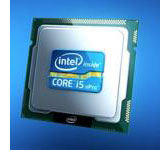 As far as the available Core i5 and i7 processor options go, i7 always signal's Intel's best, and that's the case with the available processors for the S15H. The i7 costs more, but also has more cache than the i5 option, higher base and turbo clock speeds, slightly faster graphics, and a number of additional Intel features (see full comparison of the processor options here). As far as the available Core i5 and i7 processor options go, i7 always signal's Intel's best, and that's the case with the available processors for the S15H. The i7 costs more, but also has more cache than the i5 option, higher base and turbo clock speeds, slightly faster graphics, and a number of additional Intel features (see full comparison of the processor options here).
The sample S15H GammaTech sent us had the i5 processor, the Core i5-4300M. This is a "standard voltage" mobile processor and it's plenty competent enough to drive even a high-end notebook. To see what kind of performance the big Durabook can generate, we ran our standard benchmark suite, Passmark Software's PerformanceTest 6.1, that runs about 30 tests covering CPU, 2D graphics, 3D graphics, memory, and disk and then computes scores for each category and an overall PassMark score. We also ran our second benchmark suite, CrystalMark, for confirmation and additional information. For comparison, in addition to the S15H's S15C predecessor, we included benchmark results of a variety of other Core i5-powered devices we've recently tested in our lab: the business-class Fujitsu E733 notebook, the Getac V110 convertible, the Panasonic G1 tablet, and the fully rugged Xplore iX104 XC6 tablet. None of these are direct competitors of this Durabook, but simply show where the test machine fits into the current performance landscape.
The results are as follows:
|
Gammatech Durabook S15H Benchmarks and Comparisons (PassMark 6.1)
|
|
PERFORMANCE COMPARISON
|
Gammatech
|
Gammatech
|
Fujitsu
|
Getac
|
Panasonic
|
Xplore
|
|
Model
|
S15H
|
S15C
|
E733
|
V110
|
G1
|
iX104 XC6
|
|
Year tested
|
2014
|
2011
|
2013
|
2014
|
2013
|
2014
|
|
Processor Type: Intel
|
Core i5
|
Core i5
|
Core i5
|
Core i5
|
Core i5
|
Core i5
|
|
Processor Model
|
4300M
|
M460
|
3230M
|
4300U
|
3437U
|
4300U
|
|
CPU Speed
|
2.60 GHz
|
2.53 GHz
|
2.60 GHz
|
1.90 GHz
|
1.90 GHz
|
1.90 GHz
|
|
Turbo Speed
|
3.30 GHz
|
2.80 GHz
|
3.20 GHz
|
2.90 GHz
|
2.90 GHz
|
2.90 GHz
|
|
Thermal Design Power (TDP)
|
37 watts
|
35 watts
|
35 watts
|
15 watts
|
17 watts
|
15 watts
|
|
CPU Mark
|
4,375.4
|
949.3
|
2,721.3
|
3,517.1
|
2,874.3
|
3,505.4
|
|
2D Graphics Mark
|
613.5
|
280.3
|
466.1
|
545.8
|
359.2
|
395.8
|
|
Memory Mark
|
1,774.7
|
701.0
|
940.6
|
1,000.4
|
870.8
|
1,491.2
|
|
Disk Mark
|
883.8
|
520.5
|
436.7
|
3,625.9
|
4,682.4
|
8,780.7
|
|
3D Graphics Mark
|
563.4
|
308.1
|
300.1
|
349.8
|
282.7
|
460.8
|
|
Overall PassMark
|
1,831.1
|
562.8
|
1,092.7
|
1,973.2
|
1,953.5
|
3,081.7
|
|
CM ALU
|
51,183
|
34,491
|
47,514
|
42,076
|
42,940
|
41,937
|
|
CM FPU
|
50,385
|
32,924
|
44,977
|
40,030
|
40,683
|
41,146
|
|
CM MEM
|
50,614
|
19,390
|
28,122
|
29,364
|
38,698
|
45,937
|
|
CM HDD
|
22,882
|
8,049
|
13,828
|
41,277
|
41,328
|
52,605
|
|
CM GDI
|
19,791
|
9,538
|
15,739
|
16,081
|
14,451
|
13,115
|
|
CM D2D
|
8,534
|
2,017
|
2,168
|
7,493
|
1,657
|
7,748
|
|
CM OGL
|
15,858
|
2,424
|
6,406
|
12,600
|
5,794
|
12,210
|
|
Overall CrystalMark
|
219,247
|
108,833
|
158,754
|
188,921
|
185,551
|
214,698
|
As expected, our Intel Core i5-based Durabook performed very well. The overall PassMark and CrystalMark scores indicate that the S15H is at least twice as fast as the old S15C — a very noticeable difference. So for anyone looking to replace older S15C Durabook deployments, the new S15H is a no-brainer decision.
It's often quite difficult to draw valid conclusions from performance benchmark lineups because because different architectures and configurations may yield seemingly illogical results. This is less of an issue in this group as all use Core i5 CPUs, albeit from different Intel generations. What is clearly obvious is that the graphics include in Intl's 4th generation chips are significantly more powerful than those included in earlier generations. For that reason, GammaTech is not offering a discrete graphics option for the S15H as it did for the old S15C.
One big difference in the chips used in this lineup is their TDP, the thermal design power. Intel's current philosophy is to design chips around a maximum amount of heat they generate. Lower TDP designs have lower nominal clock speeds, but can reach, for brief periods, significantly higher "turbo" clock speeds. Higher TDP designs normally operate at higher clock speeds, which means higher power consumption, but also higher average performance. "Haswell" processors, however, also include very sophisticated power conservation measures, meaning that even high-performance machines may draw very little power hen just idling along.
Do note one thing, though: in all of our benchmarks solid state disks outperform rotating media (i.e. conventional hard disks), often by a substantial margin. The 500GB Toshiba hard disk in our sample machine was quick enough, but anyone requiring top performance should definitely look into GammaTech's SSD options. SSD still costs more and available options usually have less capacity than hard disks, but if performance maters, they are the way to go.
Power and Battery Life
One of the things we criticized the predecessor Durabook S15C for was its rather small battery for such a big notebook. With 48 watt-hours it had hardly more capacity than the small Acer Aspire One netbook we use use around the office and occasionally on trips. GammaTech apparently agreed, and gave the S15H a more powerful battery.
Our sample machine came with a 9-cell 86.6 watt-hour battery, almost twice what the older S15C had. This battery is listed as the default in the S15H spec sheet, and it should be. However, the tech specs on the website list the 6-cell 57.7 watt-hour battery as standard, and the 9-cell version as an option. Even if the 6-cell is standard, it has 20% more capacity than the old S15C's battery, but we'd still advise to go with the 9-cell. Unlike some snap-in batteries where higher capacity options stick out, this 9-cell fits neatly into the machine. Go for it.
We usually run PassMark's BatteryMon utility to measure power draw under various operating conditions. Somehow, BatteryMon didn't wrk on the S15H, always showing the same draw. As is, GammaTech claims 4.5 hours for the 6-cell battery and 6.5 hours for the 9-cell version. Based on our experience with the S15H, this should easily be possible.
Display
The Durabook S15H's large display measures 15.6 inches diagonally and it uses the popular 1366 x 768 pixel format that translates into a wide-format 16:9 aspect ratio. That's like having a legacy 1024 x 768 XGA display, but about 30% wider. Almost all notebooks are using wide format displays these days, though some of the popular fully-rugged notebook lines have stayed with the old 4:3 aspect ratio for backward compatibility reasons.
Truth be told, 1366 x 768 pixel isn't terrifically high resolution on a display this large. Not in an era of "retina" displays and 1080p on smartphones. But t's still good enough, and if it isn't, GammaTech has a 1920 x 1080 pixel option.
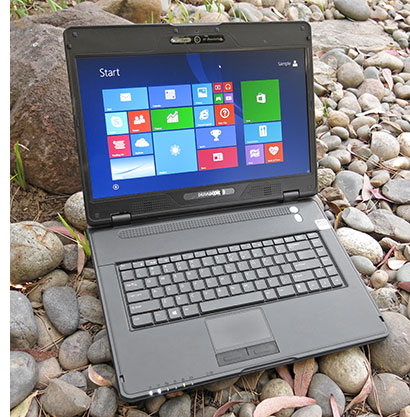 As was the case with this Durabook's S15C predecessor, we wish we could report more on the nature and technology of the display, but available information is sparse. GammaTech literature describes the S15C's screen as "brilliant" and the official brochure lists the display as sunlight readable with anti-reflective coatings and an enhanced-brightness LED backlight. However, the specs do not include a nits brightness rating. Optical coatings and enhanced brightness, of course, are the current recipe for outdoor/sunlight viewability. As was the case with this Durabook's S15C predecessor, we wish we could report more on the nature and technology of the display, but available information is sparse. GammaTech literature describes the S15C's screen as "brilliant" and the official brochure lists the display as sunlight readable with anti-reflective coatings and an enhanced-brightness LED backlight. However, the specs do not include a nits brightness rating. Optical coatings and enhanced brightness, of course, are the current recipe for outdoor/sunlight viewability.
As is, what we can report is that the Durabook's display is indeed nice and bright, and bright enough for some outdoor use. We also really appreciate that the S15H display surface is matte rather than glossy. Glossy displays may still rule in consumer notebooks and tablets, but matte displays simply have fewer reflections outdoors. Reflection, of course, is a physical fact of life, but while glossy displays reflect mirror-like, matte displays diffuse light, making it easier to view them under the typically high-contrast outdoor lighting conditions.
So without knowing a lot of specifics, the Durabook display worked quite well for us, especially for a machine that was not specifically designed as a fully rugged outdoors system.
Another display quality that we cherish are wide horizontal and vertical viewing angles. The Durabook display has an almost perfect horizontal viewing angle, but the vertical one is rather narrow, with lots of chromatic aberrations and color shifting as you change the viewing angle. We had hoped GammaTech would change that in this new version of the S15 platform.
How rugged is this Durabook?
The name "Durabook" certainly invokes connotations such as "tough," "durable," "reliable," etc., and Gammatech does refer to it as a "rugged notebook." Unfortunately, there are no standards on what exactly defines "rugged" or "semi-rugged" or even "durable" or "business-rugged" or whatever else the industry has come up with. Even the often cited MIL-STD-810G really only describe the procedures for a variety of environmental tests. What it means is that the terms are quite elastic.
 As is, GammaTech really only claims resistance to drops, shock, and spills, and describes the design limits in some detail. As is, GammaTech really only claims resistance to drops, shock, and spills, and describes the design limits in some detail.
For drops, testing is conducted in accordance with the procedures described in MIL-STD-810G, Method 516.6, Procedure IV. Drops are from a height of 30 inches, which is about the height of a tallish desk, onto 2-inch plywood over concrete. The machine is then dropped once on its six faces (front, back, top, bottom, left, and right) with the display closed and unit turned off. After each drop, the machine must be able to boot. That is not terribly impressive compared to the four (and higher) foot drops onto concrete some of the ruggeds can do, but it's in line with most semi-rugged notebooks available today.
GammaTech also states shock and vibration resistance in testing similar to MIL-STD-810G, Method 514.6, Procedure I, Category 24, Fig 514.6E-1 which simulates traveling in a truck on a highway for 1,000 miles, compressed into 60 minutes. In addition, also adherence to integrity exposure as shown in Fig.6E-1 in the same section, as well as ASTM4169, Truck Transport, 11.5.2 Random Test, Assurance Level II (ASTM stands for American Society for Testing and Materials. The D 4169 standard sets tests and requirements for strength, durability and protective capability of packaging. Level II stands for medium test intensities and is most commonly used).
On the sealing front, GammaTech concentrated on spill resistance. There is no IP rating as IP measures sealing of the entire enclosure whereas the emphasis here is on protection against inadvertent spills. As is, the S15H can handle 100cc of water dropped over its keyboard, buttons and indicator lights.
There are no operating temperature specs or some of the other specs commonly listed for semi-ruggeds and ruggeds (like altitude, humidity, temperature shock, etc.)
If you dig a bit deeper into GammaTech's materials and origin, past the official specs, you'll find that the machine offers quite a bit of vibration protection (as is evident from looking at its insides with all its shock absorption and magnesium construction) and that it's really tougher than the few supplied specs might lead one to believe. One of the problems here is that the machine can be ordered in so many different configurations that it's not always clear from the documentation and website what you can get and what specs apply.
Summary: The GammaTech Durabook S15H
The Gammatech Durabook S15H, successor to the company's earlier Durabook S15C, is a 6.6-pound notebook computer designed to be tougher and more durable than standard consumer notebooks, but without the extra size, weight and cost of a fully rugged design. It's a very solid, trust-inspiring machine with a large 15.6-inch wide-format display, good connectivity, and good day-to-day functionality.
Starting price of the Durabook S15C is low compared to fully and even most semi-rugged laptops, only around US$1,500 or so for a bare-bones machine. A mid-range version like our test unit is still only in the US$1,650 range, a good value for the money.
 Despite its low starting price, the Durabook is a every good performer. Our review unit came with the mid-range 2.60GHz Intel "Haswell" Core i5-4300M processor and achieved excellent overall benchmark results. The powerful 9-cell battery in our test system easily provided more than adequate battery life. Despite its low starting price, the Durabook is a every good performer. Our review unit came with the mid-range 2.60GHz Intel "Haswell" Core i5-4300M processor and achieved excellent overall benchmark results. The powerful 9-cell battery in our test system easily provided more than adequate battery life.
The Durabook S15H has a bright 1366 x 768 pixel wide-format display that remains usable outdoors without much reflection and glare. There is no touch screen. A 1920 x 1080 pixel display option is available for those who need higher resolution. The display surface is matte, which makes it more pleasant to use than a glossy screen. The vertical viewing angle is limited.
While it's not immediately obvious by the modest ruggedness claims, this Durabook is an exceptionally well constructed machine. Its magnesium alloy chassis should hold up for a long time, and there is plenty of shock-mounting as well as plenty of internal protection. However, while the unit can handle spills onto its keyboard and such, it is not waterproof (open cooling vents to inside on side and bottom). Examine ruggedness specs to see if they match your requirements.
Overall, the Durabook S15H with its large, modern wide-format display and late model Intel processor options is a good deal for anyone who needs a powerful, highly configurable notebook that is significantly tougher than standard consumer laptops and should hold up well in daily use.
GammaTech Durabook S15H highlights:
- Very solid and well-made
- Excellent performance with Intel Core i5 processor (i7/i5/Pentium available)
- Bright display with good outdoor viewability and modern 16:9 1366 x 768 pixel wide format
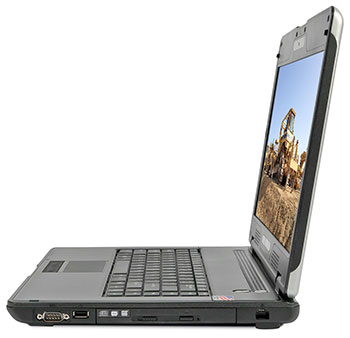 - 1920 x 1080 display option
- Display is not glossy
- Excellent keyboard and touch pad
- Very solid magnesium-alloy chassis and very clean construction
- Low starting price, and even well-equipped a good deal
- Spill-resistant design
- GammaTech does built to order (BTO)
- Now with HDMI and USB 3.0 ports
- Quiet fan doesn't come on often.
But keep in mind:
- Narrow vertical viewing angle
- Small standard battery
- Limited ruggedness (2.5 foot drop)
- No operating temperature range listed
- Adding options can quickly raise costs
- Needlessly bland design
– Conrad H. Blickenstorfer, June 2014
|
Gammatech Durabook S15H Specifications
|
| Added/changed |
Added 02/2014, full review 06/2014
|
| Type |
Semi-rugged notebook computer
|
| Processor |
Intel Core i7-4600M
Intel Core i5-4300M
Intel Pentium 3550M
|
| CPU speed |
2.9GHz, 2.6GHz, 2.3GHz
|
| Chipset |
Intel HM86 |
| OS |
Windows 7 Professional or Windows 8.1 Professional
|
| Graphics Controller/Chipset |
Core i5 and i7 models: Intel HD Graphics 4600, Pentium models: Intel HD Graphics |
| Memory |
Max. 16GB DDR3 in two sockets
|
| Display |
HD LCD (220 nits)
|
| Display size and resolution |
15.6"/1366 x 768 pixel HD, optional 15.6" 1920 x 1080 pixel FHD (300 nits)
|
| Digitizer/Pens |
NA
|
| Keyboard |
86-key, full-scale, spill-proof |
| Storage |
2.5-inch 500/750GB SATA hard disk or SSD
|
| Multimedia Pocket |
DVD super-multi drive (Panasonic UJ8E0 DVD writer in our eval unit) |
| Slots |
1 x SDXC Card, 1 x ExpressCard 54/34, 1 x Smart Card, 1 x SIM card |
| Housing |
Magnesium alloy case
|
| Temperature |
32° to 122°F (0° to +50°C) |
| Humidity |
10 to 90% non-condensing |
| Vibration |
MIL-STD-810G, Method 514.6, Annex Cat. 24, Fig. 514.6E-1; ASTM 4169-08, Truck Transport, 11.5.2 Random test, Assurance Level 2 (Operating)
|
| Sand and Dust |
NA (C-face (keyboard and display) is spill resistant, including keyboard, buttons and indicators) |
| Explosive Atmosphere |
NA |
| Enclosure Class |
Spill-proof |
| EMI |
NA |
| Shock: Functional |
MIL-STD-810G, Method 516.6, Procedure I -- 40g, 11ms Operating |
| Shock: Transit Drop |
2.5 feet MIL-STD-810G, Method 516.6, Procedure IV |
| Certifications |
EPEAT Silver, Energy Star 6.0, RoHS Compliance |
| Size (inches) |
14.6 x 10.9 x 1.5 inches (370 x 276 x 38 mm) |
| Weight |
6.6 pounds (3.0 kg) as tested, with 9-cell battery |
| Power |
6-cell 5,200 mAH Li-Ion ("4.5 hrs."), opt. 9-cell 11.1V 7,800 mAH Li-Ion ("7.5 hrs." in our eval unit)
|
| Communication |
Intel WiFi Link 1000 802.11b/g/n (optional Intel 6200 AGN); optional Bluetooth v2.1 + EDR, optional WWAN or GPS in 2nd Mini PCI Express slot, optional 1.3mp webcam |
| Camera |
Optional 2.0 megapixel webcam w/ HD MJPEG support
|
| Interface |
2 x USB 3.0, 1 x USB 2.0, 1 x RJ45, 1 x DB9 RS232, 1 x HDMI, headphone, microphone, dock
|
| Wireless |
802.11a/b/g/n WiFi, Bluetooth 4.0 Class 2
|
Price |
Starting at US$1,399 |
| Website |
www.gammatechusa.com
|
| Warranty |
2 years (mail-in); optional 2/3/4/5 year no-fault warranties |
|
| |






